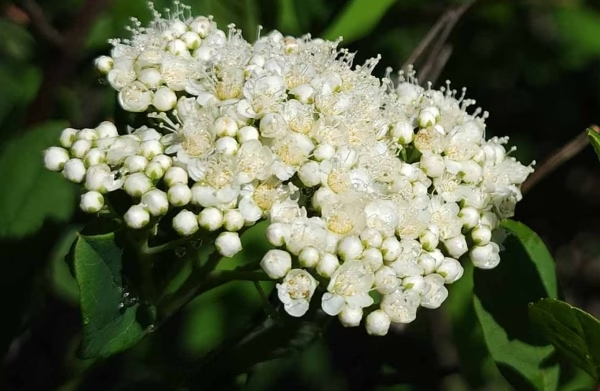
Virginia Spiraea
Botanical Name
:
Spiraea virginiana
Plant Type
:
Deciduous shrub
Seasons
:
Plant in mid to late spring or early summer; blooms in late spring to early summer
Sun Level
:
Full sun (at least 6 hours of sunlight daily)
Ideal Soil Temperature for Planting
:
60–70°F (15–21°C)
Soil Type
:
Loamy, well-draining soil
Hardiness Zones
:
5–9 (USDA)
Germination
:
14–21 days
P.H. Level
:
6.0 to 7.0
Water/Irrigation
:
Keep newly planted spirea well-watered until established; afterward, water only when the soil is dry
Fertilization
:
It is not a heavy feeder. If blooms are healthy, fertilization may not be needed. If necessary, apply a slow-release fertilizer annually in early spring
Habit
:
Upright with arching branches
Propagation
:
Seeds or division of established clumps in spring or fall
Final Plant Height
:
3–10 ft
Spread
:
2–4 ft
Flowers
:
Creamy white flowers in tightly packed bunches
Attracts
:
Bees, butterflies, and other pollinators
Uses
:
Ornamental, erosion control, rain gardens
Companions
:
Coneflowers (Echinacea), ferns, ornamental grasses
Pruning
:
After flowering, prune by cutting stems back, leaving at least five buds per stem. Remove suckers, thin out the middle branches for better air circulation, and tidy up the plant
Toxicity
:
Generally non-toxic to humans and animals
Pests
:
Aphids, slugs, snails
Diseases
:
Resistant to Phytophthora root rot
Confused With
:
Other Spiraea species, occasionally mistaken for willows due to similar foliage
Botanical Name
:
Spiraea virginiana
Plant Type
:
Deciduous shrub
Seasons
:
Plant in mid to late spring or early summer; blooms in late spring to early summer
Sun Level
:
Full sun (at least 6 hours of sunlight daily)
Ideal Soil Temperature for Planting
:
60–70°F (15–21°C)
Soil Type
:
Loamy, well-draining soil
Hardiness Zones
:
5–9 (USDA)
Germination
:
14–21 days
P.H. Level
:
6.0 to 7.0
Water/Irrigation
:
Keep newly planted spirea well-watered until established; afterward, water only when the soil is dry
Fertilization
:
It is not a heavy feeder. If blooms are healthy, fertilization may not be needed. If necessary, apply a slow-release fertilizer annually in early spring
Habit
:
Upright with arching branches
Propagation
:
Seeds or division of established clumps in spring or fall
Final Plant Height
:
3–10 ft
Spread
:
2–4 ft
Flowers
:
Creamy white flowers in tightly packed bunches
Attracts
:
Bees, butterflies, and other pollinators
Uses
:
Ornamental, erosion control, rain gardens
Companions
:
Coneflowers (Echinacea), ferns, ornamental grasses
Pruning
:
After flowering, prune by cutting stems back, leaving at least five buds per stem. Remove suckers, thin out the middle branches for better air circulation, and tidy up the plant
Toxicity
:
Generally non-toxic to humans and animals
Pests
:
Aphids, slugs, snails
Diseases
:
Resistant to Phytophthora root rot
Confused With
:
Other Spiraea species, occasionally mistaken for willows due to similar foliage
Written by Nondiah Khalayi – https://www.linkedin.com/in/nondiah-khalayi/

